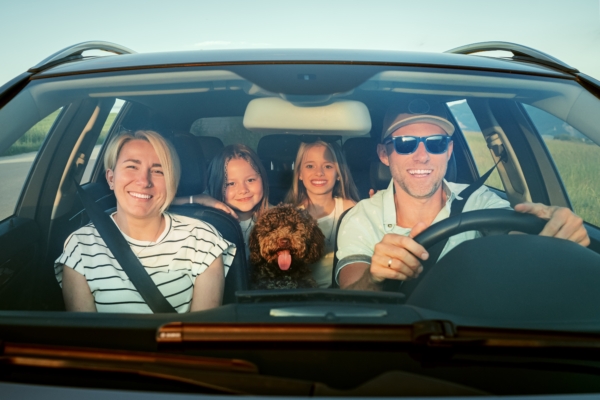Dog owners may take their furry friends on road trips in their cars. A recent study shows that if you drive an electric vehicle instead of a petrol car, your dog will be more relaxed. For those who don’t have an electric car but still take their dogs for rides, experts also provide several suggestions on how to keep them calm during car journeys.
Czech car manufacturer Škoda, in a recent press release, pointed out that a study conducted by British veterinarian and canine expert Scott Miller in collaboration with the company found that dogs ride in electric cars with less stress and are less likely to bark compared to riding in petrol cars.
The study involved monitoring a dog’s heart rate while riding in three different Škoda vehicles: the Elroq electric SUV, a petrol car, and a diesel car. The dog, a one-year-old Cocker Spaniel named Mango, was the subject of the study.
The vehicles traveled at speeds of up to 70 miles per hour. Mango’s heart rate was monitored during each journey, and measurements were taken at the end of each trip.
The results showed that Mango’s resting heart rate was 80 beats per minute. When riding in the electric car, it increased to 100 beats per minute, while in the petrol and diesel cars, it increased to 120 and 125 beats per minute, respectively. This indicates that riding in petrol and diesel cars caused more stress for Mango.
Moreover, Mango appeared to be more relaxed when riding in the electric car. It spent most of the time lying down and almost fell asleep. In the petrol cars, it seemed more restless and agitated.
Canine behavior expert Anna Webb explained that dogs’ hearing is four times more sensitive than humans’, allowing them to pick up on frequencies of traditional engine noise that humans cannot hear. Similarly, the vibrations from petrol and diesel cars could cause motion sickness, making Mango feel nauseous and elevating its heart rate.
Regarding the study findings, Miller said, “This experiment clearly demonstrates the health and psychological benefits for dogs traveling in electric vehicles. Observing Mango’s reactions to different vehicles traveling at the same speed on the same road clearly indicates that electric vehicles provide a smoother, calmer experience.”
He added, “The quiet mechanics, gearless operation, and spacious interior of electric cars create a comfortable environment for dogs, ensuring our furry companions have a more relaxed and enjoyable travel experience.”
A survey conducted by Škoda among 1,500 dog-owning car owners supported these research findings. In the survey, 53% of respondents said they take their dogs for a ride at least once a week. However, over half (54%) completely avoid driving with their dogs, and 51% skip specific trips when their dogs must accompany them.
The survey also revealed that nearly a third (32%) of car owners worry about their dogs feeling anxious during car trips. Other concerns included dog safety (38%), limited space in the car (7%), and difficulties in securing their dog’s safety (7%).
Additionally, about one-third (31%) of car owners believe that electric cars offer a quieter and more comfortable riding experience. Therefore, the acceptance level of dogs seems to be becoming an increasingly important consideration when choosing a new household vehicle.
Webb provided 10 tips to help keep dogs calm while driving, applicable whether you drive an electric car or not, as outlined below:
– Make them feel secure – Train your dog to stay in a pet carrier or crate, or fasten them with a seatbelt. This creates a safe and protective space for them.
– Watch for signs of stress – If you notice stress signs in your dog such as barking, whining, drooling, panting, chewing paws, licking, or biting the crate/seatbelt, take a break to calm them down.
– Gradually increase driving distance – From the dog’s perspective, a vehicle is a confined space with no escape route, causing stress. Start with short trips and gradually increase the driving distance to ensure each journey has a positive impact.
– Create a consistent positive environment – Play music inside and outside the car to familiarize the dog with the surroundings using sound therapy.
– Listen for sound cues – When dogs can’t express discomfort, anxiety, and stress through body language, they make suggestive sounds like whining, howling, barking, and panting. When you hear these sounds, stop the car and take a break.
– Manage volume – Since dogs’ hearing is four times more sensitive than humans’, they can hear high and low-frequency sounds. Pay attention to engine noise, other vehicles, rain sounds, and lower the volume of the radio or music played.
– Ensure proper ventilation – Vibrations from traditional vehicles can cause dogs to feel motion sickness and nausea, and their keen sense of smell (over 1,000,000 times more sensitive than humans) can make them dizzy from smells. Drive smoothly and ensure adequate ventilation in the car.
– Stay calm – Previous studies have shown that dogs can smell when people’s cortisol levels (also known as stress hormones) rise, causing them to feel pessimistic. So, it’s essential to stay calm while driving to keep your dog calm and optimistic.
– Monitor the car’s interior temperature – Dogs have a higher body temperature than humans. Keep the rear temperature below 20 degrees Celsius and carry a bottle of water with you.
– Plan the journey – Drive earlier or later in the day to avoid hot weather or peak traffic times, and take breaks every so often to make your dog more comfortable and mentally prepared for the next leg of the journey.

